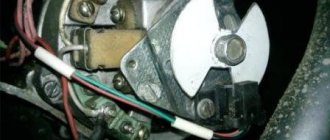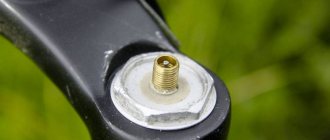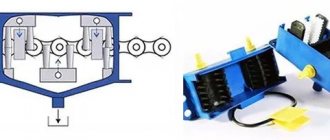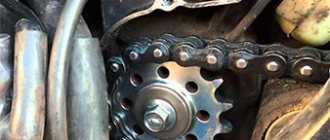Let's imagine a situation - you took your motorcycle out of the garage at the beginning of the season and decided to ride around the city. You stop at a traffic light, start, turn - and the chain breaks. The motorcycle falls, there is a crack on the body. (Okay, if not in your leg.)
It's too easy to make mistakes when caring for your chain, which is why we all make mistakes. Cleaning and lubricating it again is a long and dirty job, which you are always reluctant to do. It is much easier to succumb to the temptation and take the easy (but wrong) route - periodically rub in thick lubricant and use liquid detergent as a cleaner. Moreover, the problem is solved: the creaking has disappeared, which means everything is in order. However, from this moment something begins that eventually leads to expensive repairs: dirt accumulates, which sooner or later will destroy the chain.
A similar situation can happen with a bicycle. Imagine that you decide to go out of town. No one has lubricated the chain since purchase, and you are driving with headphones on, so you don’t care whether it squeaks or not. Well, what if the chain breaks and there are no workshops in the area?.. What if this happens when a child is riding a bicycle?..
Why does the chain break?
Chain drives are most often installed on motorcycles, bicycles and agricultural machinery. And for good reason - after all, the chains are lightweight and can be adapted for equipment of any size. And chains and sprockets are cheaper than cardan or belt drives.
The main disadvantage of the chain is that it is a moving and open mechanism. If there is no lubrication on it, its links and bushings will begin to rub against each other and wear out over time. And if the lubricant turns out to be sticky, then it will attract dirt, which will also wear out the chain: it will stretch, begin to slip on the sprockets, or even break.
Conclusion: the chain must be lubricated, but remain clean. There are two ways to achieve this:
- Install an automatic chain oiler on a motorcycle. Such a system costs from 7 thousand to 12 thousand rubles. It will always lubricate the chain - however, dirt will stick to the lubricant, especially if you often drive on sand and dirt.
- Clean and lubricate the chain by hand regularly. This method takes time, but it is cheaper and not as tedious as it seems.
Types of lubricants for motorcycle chains
It’s unlikely that anyone would want to change the chain twice a year. It is much more profitable to regularly buy suitable lubricant for it. For this purpose sprays or graphite are used.
Aerosol lubricants
This type of lubricant is more popular. They are released in cans. Sprays are convenient to spray in hard-to-reach places, but during spraying you need to make sure that the product does not get on the rim or tire.
Lubricant is applied to the cleaned chain (on the oil seals, which should be elastic), then evenly sprayed along the chain as the wheel rotates. The spray lubricant should dry within 20 minutes.
Graphite lubricants
This type of lubricant will stay on the chain longer, but this thick product is difficult to apply. As a rule, graphite lubricant is mixed with some kind of oil and only then applied to the chain.
Nowadays graphite motor lubricant is used quite often. A device with graphite lubricant is mounted on the motorcycle’s pendulum, and a thin layer of lubrication is carried out automatically. The result is continuous and uniform lubrication of the chain structure. There is no excess or accumulation of lubricant under the parts. Due to its composition, graphite lubricant repels dirt.
The effect of such a product is designed for 6000 km, after which it needs to be replaced. Even with precipitation, liquid flows will not wash away such lubricant. At the same time, the appearance of the lubricated chain remains like new throughout the entire time.
How to clean a chain
You can clean the chain using non-aggressive solvents - white spirit or kerosene. But then you will have to clean the chain with a brush to push out dirt and old grease from the links. Another option is to remove the chain and bathe it in solvent. Both procedures require time and technical training, because not everyone knows how to remove the chain.
It is more convenient to use a special chain cleaner in the form of an aerosol. Shake the can and direct the stream at the links - this will push out dirt and old lubricant.
Spray the entire chain with an aerosol and wait for the remaining cleaner to flow down. Then wipe the chain with a rag, and when the chain is dry, apply lubricant. Be sure to wait until it dries completely - otherwise the remaining cleaner will dissolve the lubricant and the chain will remain dry.
Cleaning
Experts recommend starting to clean the chain after a short drive - an hour will be enough. This will allow the chain to warm up to the desired temperature, making its lubricant less thick. In this state, it will be much easier to wash all deposits from the chain, and the new lubricant will be able to penetrate much deeper into the friction pairs. If you want to wash the motorcycle at the same time as cleaning the chain, do this only after servicing the transmission, since during such work a lot of dirt and grease will leak onto the body of the bike. There are two main ways to clean a chain, using different tools.
Manual method
The most common method among Russian motorcyclists is cleaning the chain with a toothbrush. Instead, you can take a narrow shoe brush with soft fibers or a special tool sold in a motorcycle parts store. Do not use metal brushes or tools with very coarse fibers as they can easily damage chain components.
You will also need to purchase a cleaning liquid - Liqui Moly, Hi-Gear and Motul have suitable spray cans in their range. If you don’t have such a product at hand, the chain can be cleaned with kerosene, but you should prepare for a significant increase in the labor intensity of such work. You cannot use gasoline to clean the chain, as this will lead to the dissolution of the O-rings, bushings and seals - as a result, the part will have to be thrown away.
The motorcycle is mounted on a stand or on a suspension - the rear wheel must be in the air. The can of liquid should be brought in from the wheel side. Its nozzle should be directed outward, since contact with such an aggressive chemical compound on the wheel can be dangerous for the rubber. After applying the liquid to the upper part of the chain, spin the wheel and repeat the procedure so that the entire part is covered with a special cleaning agent. After waiting approximately 5 minutes, begin brushing the transmission, paying special attention to gaps and seals.
If you need to learn how to clean a chain with kerosene, then you should understand that in this case you will have to spend a lot more time. The liquid is applied to the part in a thin stream, and care must be taken that its splashes do not fall on the wheel. After 5 minutes, begin to thoroughly remove the dirt with a brush, trying to penetrate the fibers as deeply as possible. If it was not possible to completely clean the chain in this way, it will have to be removed, which will take a lot of your time and effort.
Automation
For those who are interested in the best way to clean a chain, we can recommend using a special device - this is produced by KETTENMAX, as well as some other manufacturers of motorcycle accessories. The bike needs to be lifted by hanging the rear wheel, and then started. The device is attached to the chain - inside there are special rollers and brushes that allow you to pass the chain while simultaneously cleaning it from all possible deposits. At the top there is a tube for supplying cleaning liquid - it can be either a special product supplied in the kit or regular kerosene. There is a tube at the bottom for draining dirty cleaning liquid - it is better to lower it into a tray or half-liter bottle.
After making sure that the device is securely attached to the chain, engage first gear, but do not add gas. Now your task will be to ensure an even flow of cleaning material into the device - it must be gradually poured or injected into the upper tube, making sure that the liquid does not fall on the motorcycle itself. After about five minutes, the chain will be completely cleaned, after which you need to turn off the gear and turn off the motorcycle engine.
Before lubricating the chain, you will need to rinse off any remaining cleaning fluid - otherwise the oil will not be able to adhere to the part. To do this, use water at room temperature - it is better to pour it out of a simple plastic bottle in a thin stream, gradually turning the chain. Do not use a high-pressure washer under any circumstances - it very quickly destroys the motorcycle transmission, shortening its service life. After washing, carefully dry the chain with a non-abrasive material - a microfiber cloth will do.
What and how to lubricate the chain
Lubricating a chain seems like a matter of two seconds. We take any technical lubricant, apply it to the links - and you're done. But not every lubricant is suitable for open drive chains. For example, thick lubricants like lithol or grease are intended for closed mechanisms that are protected from dust and dirt. The chain is located outside - after lithol it will collect two to three times more dust, which will accelerate its wear.
Only non-stick lubricants are suitable for open chains. ASTROhim has one, for example. It will create a lubricating film resistant to salts and water on the surface and protect the chain from excessive wear. Be sure to shake the can well before use.
After using a non-stick lubricant, links and seals wear less, and the chain and sprockets can be replaced less frequently.
Useful feature: ASTROHim chain lubricant is blue. This will help you see where it has already been applied.
In general, caring for the chain does not require much effort and is not difficult. It is enough to clean the chain well and apply lubricant. The main thing is to do it on time. The frequency depends on the operating conditions of the equipment.
Motorcycle Chain Lube Manufacturers
Lubricant manufacturers claim that motorcycle chemistry is selected depending on the area of use of the vehicle:
- to reduce friction;
- to prevent the adhesion of sand and dust;
- so that the lubricant dries quickly and does not leak out from under the seals.
For example, for enduro, the manufacturer provides lubricant properties that prevent the adhesion of sand and dust. Lubricant for sport bikes is designed to ensure that the chain structure operates efficiently at high speeds so that it does not leak from under the links. Taking into account the fact that in certain sports disciplines every second can affect the result, a sticky synthetic lubricant with increased grip (for use at high temperatures) has been developed for the fastest motorcycles.
The ideal lubricant can be selected according to the manufacturer's instructions in the instructions. According to the area of application, manufacturers divide the lubricant into the following types:
- universal;
- road;
- to sportbikes;
- for motocross and off-road motorcycles;
- to old motorcycles.
If you have difficulties choosing the appropriate lubricant option, it is better to contact a specialist in a motorcycle service center.
It is best to use special lubricants produced by such popular manufacturers as Liqui Moly, Motul, Motorex. The products of these brands are most in demand:
- Motul Chain Lube Factory Line . The most popular lubricant option from this company. Suitable for all chains, but especially for road and sports vehicles. Helps reduce friction and power loss, thereby increasing the service life of the product. Shows excellent grip in minutes.
- Motul Chain Lube Off Road . Standard and ring-shaped bushings are treated with this lubricant. Recommended for use in off-road motor vehicles. Thanks to the special composition, the adhesion of sand and dirt is prevented.
- Ipone Sand Chain . Aerosol lubricant, optimally suitable for motor vehicles when operating in sandy areas. When used, a protective film is formed to prevent abrasive wear and sand adhesion.
- Ipone Racing Chain Blue . High-quality Teflon-based product suitable for use in extreme situations at high speeds. It has excellent protective properties and is moisture resistant.
- Presto Ketten-Spray . Has excellent lubricating properties. It can even withstand the effects of household chemicals - after washing the motorcycle with foam, there is lubricant on the chain. The cylinder is designed for 6000-7000 kilometers.
When to clean and lubricate the chain again
Ideally, the chain should be cleaned and lubricated regularly - it all depends on where and how you used the equipment. The more dirt there is on the road, the sooner you will need to clean your chain. Especially if water gets on it. The main indicator of a dirty chain is crunching, whistling and other unpleasant sounds. But it is better to clean the chain before it starts to “whistle”.
For example, on a motorcycle, the chain needs to be cleaned every 500–1000 km of driving on dry asphalt. If you ride on dirt or sand, you will need to clean the chain more often. And if you get caught in the rain, you will have to take out the cleaner and lubricant immediately after the trip.
The chain can be cleaned less often. But remember that with this approach it will wear out faster. At best, you'll buy a new chain and sprockets sooner. At worst, there is a sudden break in the circuit. If you regularly clean the chain and use lubricant, the chain will last for 20–30 thousand km of driving.
Regular Maintenance
It is worth remembering that only following all the rules for caring for a motorcycle will help you significantly extend the maximum life of your two-wheeled equipment. Regularly lubricating the chain, checking the condition of transmission components, and cleaning the transmission mechanism from dirt will help put off expensive repairs for tens of thousands of kilometers. If you neglect this need, this can lead to disastrous consequences - the gearbox may jam while in motion, which will cause an emergency. That is why many motorcyclists try to lubricate the chain as often as possible, trying to avoid trouble. If you don’t want to deal with such dirty work, you can entrust it to the specialists of a motorcycle service station - the advantage of this option will be the ability to carry out comprehensive diagnostics when servicing your equipment.
Chapter 1. Design and wear
The chain consists of links (external[1] and internal[2]) links - from cheeks (external links from external[3] and internal from internal[4]), pins[5], guides[6], rollers[7] and oil seals (if we are talking about stuffing box chains)[8]. Well, lubricants (not shown in the picture). The inner cheeks are connected by hollow guides, the outer cheeks by pins, and the pins (through the guides) connect the chain links into a single whole.
Motor chain device
So why does the chain “stretch” and how does wear affect the length of the chain? Friction, you heartless bitch! During operation, the chain elements rub against each other. The pins rub against the guides, wear out and become thinner, the internal diameters of the guides and rollers increase, and the external diameters decrease, as a result, the gaps between the roller - guide - pin increase, the pitch in the internal links of the chain increases, and the rollers begin to dangle. The pitch of each individual link - the distance between the pin axes of the outer links [A] and the guide axes of the inner links [C] - remains unchanged throughout the life of the chain, since the cheeks of the chain are made of steel, which does not stretch (I wrote about this above ). However, due to wear of the pins and guides, the distance between the centers of the pins of the internal links [B] increases during operation of the chain! And due to this, the total length of the chain increases.
This is how it turns out that the linear dimensions of each individual link do not change, but the chain “stretches”. What conclusion can be drawn from all this? During the operation of the chain, the pins wear out the most [5], their diameter decreases and the strength of the entire chain decreases, increasing the risk of its breakage! I don’t think there’s any need to explain what the consequences of a broken circuit are? So options like “can I shorten the chain, otherwise it’s no longer tensioned?” for those who like to take risks.
Daytona
Daytona is marketed as a specialty chain lubricant. Its physical properties are similar to Teflon-based compounds. Let's be honest - the Daytona does an excellent job of lubricating links, but it is not without its drawbacks.
The main disadvantage of Daytona grease is that it is too thick. But why is this bad? Thick lubricant quickly collects sand particles that get stuck in its structure. After some time, this composition turns into a real abrasive, which has a negative effect on parts and can lead to damage. Therefore, dirty grease must be removed and reapplied.
Automatic method
You can automate the process of lubrication of a motorcycle chain using special devices, such as a motorcycle chain cleaning machine. This is a small box that attaches to the chain and cleans it using internal rollers. Lubricant or cleaning agent is poured from above, and from below there is a drain for dirt and oil directly into the appropriate container.
All you have to do is attach the motorcycle chain cleaner, place the bike on the center stand, start it, put it in first gear and monitor the cleaner level, topping it up as needed. The job will be completed in just five minutes with brilliant results.
Rohloff
Rohloff is the ideal lubricant for bicycles. It is designed for mountain bikes and withstands difficult operating conditions, high and low temperatures. Many experts recommend using it for processing bicycle chains and other bicycle components.
The disadvantage of Rohloff oil is its high cost, approximately 600-900 rubles per jar. But this lubricant has low consumption; one package can be used throughout the season.
Common mistakes
- Complete disregard for the need to lubricate and clean the links. The result is rapid failure of the chain or sprockets, and rapid wear of the teeth. The cleaning procedure is necessary after every ride in the rain, off-road or on dusty roads. If your driving routes were mainly in the city, lubrication will be required every 500 km.
- Use for cleaning metal brushes, brushes, brushes. This is strictly prohibited. Even brushes with natural bristles can damage the seals, be careful.
- Pinched fingers when turning the wheel with the sprocket. Getting carried away, or catching a glove on a sprocket, can significantly damage your limbs.
I was prompted to write this article by numerous articles and video reviews in which lubrication of the chain from a can is presented as the only correct way to care for the chain, and the manual’s recommendation to lubricate the chain with transmission oil is perceived as something unworthy. Often among motorcyclists, the choice of engine oil or chain lubrication becomes a matter of religion. While respecting all religions, I would like to note that in technology, “religion” arises where basic knowledge is lacking. I am not advocating for anyone to change their views, but I am just suggesting that they look at some points from a slightly different angle. Applying lubricant from a can will be a little faster than applying transmission lubricant with a brush or toothbrush. However, the time difference is not so great and is clearly not worth the money. General contamination of the motorcycle is present in both cases, and the fundamental difference here is made by how one or another lubricant is used. It is possible that the transmission will have to be washed off the motorcycle a little more often. However, is this myth so scary that the spray can sellers scare us? You can remove oil stains from the pendulum by lightly moving a rag lightly moistened with gasoline. But to remove dried “plasticine” you need to try hard. When traveling, if you don’t buy another can of spray in a large city in time, you may be left without lubricant. The volume of luggage taken up is also not in favor of cylinders. You can buy an additional transmission in any hole and it costs a penny. And its consumption of 80 - 120 miLitres per 1000 km allows you to carry a small volume of it with you. If necessary, it can even be replaced with motor oil.
ABOUT QUALITY
We all love our motorcycles and try to service only high-quality materials.
Now let’s look at the quality of chain lubricants. Motor oils, transmission oils and greases have a number of parameters that determine their quality. Look into those. characteristics of lithol or engine/transmission oil and you will see a dozen numbers that the manufacturer indicated and by which we can judge the quality of the lubricant. Also, lubricant manufacturers are trying to enlist the support of the automaker by obtaining their approval for their products, and also obtain an API license. Before issuing such documents, the automaker or API conducts both laboratory and motor tests. Not a single motorcycle engine oil, much less chain lube, passes such tests. The vast majority (99 out of 100) of motorcycle motor oils not only do not have approvals from motorcycle manufacturers, but have never had and do not have an API license. And this is in no way a guarantee of quality. Assurances from marketers such as “we recommend” or “it matches” do not count. A document cannot be replaced with words. And if the manufacturer at least provides the same technical data for motor motor oil (even without licenses/approvals), then even this information is missing for chain lubrication. A natural question arises: is this a lubricant? The amount of technical information is zero! The volume of test documents is zero! All that remains is faith. Faith to the manufacturer and its marketers. Perhaps I’m being picky: why do you need a document for some kind of chain lubricant? After all, it's just a chain, not a motor. Firstly: this “some kind of lubricant” costs 8 - 11 times more than regular grease/transmission lubricant. Secondly: indicating those. data on its products, the manufacturer thereby guarantees the stability of its properties, bearing responsibility for its quality. Thirdly: the lack of information at such prices is a simple lack of respect for the consumer.
A BIG DISCLAIMER: JASO MA (MA 2) does not research oil quality. MA approval is a conditional guarantee against clutch slipping. Ideally, ordinary water easily passes this test.
WHAT AND HOW WE LUBRICATE
Applying lubricant to the oil seals so that they do not dry out. Here, lubricant from a can has an advantage, since, having the consistency of plasticine, it stays on the chain longer than the transmission, which lasts for 200 kilometers. However, is this so important if, while traveling, one way or another you stop approximately every 200 km to refuel or rest? Penetration of lubricant under the roller. The roller is a hollow cylinder. Try filling a glass with liquid by placing it flat on its side and dripping from the top at a 90-degree angle onto its rim. Did a lot get inside? What if you stop dripping, leaving the maximum possible amount of liquid, such as vegetable oil, on its edge? Will a lot continue to come in? And this is in an empty glass! The roller is filled with a bushing and a pin, which makes filling it with lubricant even more difficult. In general, no one knows how much lubricant gets there, but if you use your imagination, you can guess that it is very little. The experiment with filling a glass is not entirely correct, since both the glass and the liquid on its surface are in a stationary state. Since the rollers rotate around their axis while the chain moves, it can be assumed that this movement will contribute to the penetration of oil under the roller. Liquid oil. This assumption, for obvious reasons, is not correct for lubricant from a can. The solvent included in its composition dries quickly - within 10 minutes it will thicken to such a state that it cannot penetrate anywhere. Of course, immediately, when leaving the container, it has very good penetrating ability since its viscosity is much less than the transmission, but this process is very limited in time and the chain along with the rollers is motionless at this moment. Let the transmission slowly but surely penetrate under the roller as long as it is on the surface of the chain in sufficient quantities. The chain completely resets it after about 170 - 200 km. (on dry asphalt when driving 100 - 130 km/h). We can assume that at least the first 70 - 100 km. mileage, the transmission enters under the roller. So, if you paraphrase a famous advertisement, it would be like this: “Are you already dry? And we are still working!” Lubrication of the roller-star pair. Here, any lubricant will run out very quickly
is not renewed My opinion is that after 40 - 70 km. There will be no trace of ANY lubricant left on the outer surface of the rollers. But here you can “play” with the transmission by making an auto lubricator. Resuming lubrication in motion, you can be sure that these friction pairs operate in high-quality and certified/licensed lubricant. the penetration of lubricant under the seal (oil seal) . The purpose of the seals is to seal these friction pairs. And if the tightness is already broken, then no lubricant will stop the accelerated wear of the chain.
COMPATIBILITY OF LUBRICANTS WITH SEALS
The manuals recommend not washing the chain with aggressive solvents so as not to damage the seals. However, all cans contain some kind of solvent to ensure the release of lubricant. Nobody knows what kind of solvent it is. The degree of its aggressiveness towards seals is also not known. The marketing text: “...does not harm chain seals...” is just text. In such situations, documentation of the tests performed must be attached. Has anyone seen them? The only good thing is that, due to its volatility, the time of its influence on the seals is minimal.
Conventional greases and transmission/motor oils are solvent-free. And one of the mandatory requirements for their production is their compatibility with seals.
DIRT STICKING TO THE CHAIN.
There are horror stories all over the Internet that if you use a transmission, then when driving on dirt roads an incredible amount of sand will stick to the chain, thereby accelerating its wear.
I think that these fears are created either by those who have never used anything other than a spray can, or by those who sell this type of “lubricant” themselves. I have experience using both lubrication options. No critical adhesion of dirt was observed in any of them. Without going into details. If you find fault, then it is the lubricant from the can, due to its “stickiness,” that stays on the chain longer and the sand that gets into its “sticky paws” accumulates on it. However, this happens at the edges of the chain in the area of the seals. As for the roller-star friction pair, options are possible here. If, after applying the lubricant, you drive for tens of kilometers on asphalt and then slide onto the ground, then by that moment the rollers will be almost without lubrication and the accumulation of sand on them will be minimal. Well, if you apply lubricant before a dirt road, then it will take in more sand and will stay on the rollers with it for some time, “delighting” both the rollers and the stars with this “gift”. At the end of the dirt road, if everything is done correctly, then you need to stop, wash off the old lubricant that has accumulated sand and apply new one. Now about my experience using the transmission. Sand falling on the chain begins to absorb liquid transmission oil, thereby forming quite heavy and at the same time loose fragments, which, under the influence of centrifugal force, are immediately catapulted from the chain. The chain simply dries out after a couple of kilometers. There can be no talk of any accumulation. In order not to drive with a dry chain, you need to either lubricate it every few kilometers, which I personally am too lazy to do, or change the setting of the auto-lubricator (if there is one). In principle, nothing bad will happen to an O/X-ring chain even if there is no lubrication on it at all, provided that your mileage on dirt roads is short. If we analyze in detail the accumulation of sand in the transmission oil during operation of the lubricator, we get the following picture: with an increase in the dosage of oil, its volume on the chain significantly exceeds the volume of sand, the sand simply does not have time to absorb the oil, as I wrote above, on the contrary, the opposite picture occurs — large drops of oil, together with the sand that has fallen into it, are thrown off by centrifugal force. The accumulation of a critical mass of oil on the chain occurs faster than the accumulation of sand. Centrifugal force and increased oil dosage simply constantly “wash” the chain. Abundant ingress of sand onto the chain is typical only for areas of “quicksand”, as well as “mud baths”. When driving onto a dry, rolled primer, the chain is quickly cleared of sand residues, receiving a sufficient amount of fresh oil. All this happens in motion without your participation. Using my transalp for fishing trips, I accumulated some statistics. For the last three seasons, an auto-lubricator has been installed on it, and through experience I have determined its most optimal settings. When driving on dry asphalt: 1 drop every 2 or 2.5 minutes. When driving on dirt roads with a lot of sand: 4 - 5 drops per minute. In the presence of fords or puddles: 7-8 drops per minute. Such a significant increase in dosage is necessary to avoid driving with a dry chain. Of course, after such abundant lubrication off-road, traces of dirt remain, but these are stains from oil, not sticky dirt.
And they remain on the wheel and pendulum. There is always the option of not increasing the dosage so that the motorcycle remains clean and beautiful, especially if you are driving through the forest to a neighboring village for a disco. When driving on asphalt, the need to clean the pendulum and wheel from traces of oil occurs approximately every 500 - 800 km. MOTORCYCLE CONTAMINATION
There is an opinion that the entire motorcycle is covered in transmission oil if there is no such chain protection as in the photo:
It is quite possible that this is so. I have it and all the excess accumulates under it, as well as in the area of the leading star. Excess oil also ends up on the wheel and pendulum. In what cases is there excess oil on the chain? When applied with a brush (or toothbrush) in the first 10 - 20 km. mileage If after these 20 km. Wipe the wheel and pendulum with a rag slightly moistened with gasoline, then until the chain is completely dry, there are no problems with contamination. You can also significantly reduce the spread of oil if, after applying it, you let the motorcycle stand for a while (the longer the better), and before starting to move, lightly wipe the chain with a dry rag, thus removing excess oil from it.
The myth about auto lubricants polluting motorcycles. The myth may well become reality if the lubricator is made in such a way that the oil flies past the chain when moving . When making it, it is necessary to take into account the speed and direction of the wind, as well as the angles of inclination of the motorcycle in motion. The work of an auto lubricator will also lead to contamination if the oil dosage is higher than normal. This is especially true for gravity-flow systems without electronic control. At the beginning I had one too. Experience traveling to Altai showed its strong dependence on ambient temperature. The viscosity of the oil and, accordingly, its fluidity changes greatly. If the auto lubricator is made correctly, then the spreading of oil on the pendulum and wheel will be minimal. Before the trip, it is enough to briefly inspect the chain and if there is enough oil on it, then the lubricator does not need to be turned on . And if necessary, lubricate it, just press the button to set the required operating mode.
We all know that the dirtiest place is under the motor sprocket cover. Any lubricant accumulates there, and dirt accumulates along with it. Let me give you two examples of photos of my motorcycle after running 2,000 km. of which 60 km. It was passed along dirt roads, including sections of sand, both in a straight line and with slipping uphill. This, of course, is not a long mileage, but at the time of writing there are only such photos.
The first photo is at the beginning of the article.
And this is the lid itself
REMOVAL OF OLD GREASE. COMPARISON.
Even ardent supporters of spray lubricants, as well as some instructions for these lubricants, recommend cleaning the chain of old lubricant before applying new one.
This is quite logical, since due to its special stickiness, it accumulates on the chain along with dirt. I will not dwell on this point, since both cleaning agents and methods are known to everyone. The only question that remains open for me is: is the old dried grease, which has accumulated dust and fine abrasive, removed from under the rollers? This is the first thing. Secondly, for me, as a notorious lazy person, the procedure for washing the chain after every 500 km. not acceptable even at home, and even more so when traveling. The transmission , regardless of whether you use a brush or a lubricant, is constantly thrown off the chain, taking with it the dirt that gets into it.
There is no need to wash the chain so often. When driving on asphalt, it is enough to rinse with diesel fuel once every 5,000 km. Although I didn’t wash even once while I was traveling to Altai (9,000 km). It will also be easy to wash out from under the rollers. OIL FOR CHAINSAW CHAINS
This product is sometimes discussed on motorcycle forums as a motorcycle chain lubricant.
In advertising texts for these oils they write about their remarkable properties: “Penetrates well”, “good adhesion (sticking) to the chain”, etc... The statement that the oil has such mutually exclusive properties only indicates that we are reading another marketing nonsense. A lubricant that has a constant viscosity also has constant properties: if it penetrates well into the gaps of the friction pairs due to its low viscosity, then it is released from the chain just as well; If it holds well due to high viscosity, it penetrates into gaps less well. Motorcycle lubricant from cans has these properties precisely because it has a variable viscosity: very liquid when it comes out of the can, due to the presence of a solvent, and thick/sticky after the solvent evaporates, when the thickener in its composition acts.
There is no technical information for most chainsaw chain oils. Only some manufacturers provide little information about this product. Based on this information, you can get the idea that these are the most common motor or transmission oils. Information on viscosity (in special units) provided in the documents indicates that these oils correspond to motor oils: 10-W-30, 10-W-40, 10-W-50. As you can see, the spread here is very large. Everyone pours into cans what they see fit. If we do not take into account biodegradable oils, it turns out that none of the manufacturers have ever provided reliable and documented information that saw chain oil is in any way unique and different from conventional oils. Everyone can decide for themselves whether they are worth buying. However, in this regard, the reverse replacement is also very interesting: I have never seen or heard of anyone using motorcycle grease from a can to lubricate a chainsaw chain. The conditions in which a chainsaw chain operates are comparable to the conditions of hard enduro (or cross-country) for a motorcycle chain. After all, many crossmen and endurists use spray cans for their chains, being in full confidence that they thereby reduce its wear. Why not use it for a chainsaw? Maybe there is a fear that the thin slot on the bar along which the chain moves will become so clogged that the chain will stop? I am sure that if you stuff ordinary Litol-24 into this slot, nothing catastrophic will happen, because Litol is a full-fledged lubricant, which, even in conditions of severe contamination, will continue to function as a lubricant. What if from a spray can? If anyone has similar experience, write in the comments how much it extends the life of saw chains.
Liquimolli has a biodegradable chainsaw lubricant based on vegetable oils. In this case, we see a truly specialized product, significantly different from conventional oils. And if you are an ardent fan of Greta Thunberg, then you should pay attention to this product.
QUESTION PRICE
If the container indicates “volume 400 ml,” this does not mean that the volume of lubricant there is exactly 400 ml. The product volume there will be a maximum of 300 ml. In these 300 ml. a solvent is also included, the volume of which is unknown. Keep this in mind when you want to compare costs. There is no point in using expensive motor or transmission oils to lubricate the chain for a number of reasons. Ordinary mineral water has excellent lubricating properties, not at all inferior in terms of wear protection to expensive esters. Low-temperature fluidity is not needed here; stability of properties at high temperatures is also not necessary. Everyone in their region can calculate the difference in cost themselves. I got the one I voiced a little higher.
IN CONCLUSION NOT MUCH HUMOR
Let's look at examples of documents where technical specifications are indicated. characteristics of lubricants.
This is what a normal document looks like (everything is serious here):
Here is a document from a WELL KNOWN company for conventional grease. The information is not complete, but you can get at least some idea of the quality. AND HERE FOR BIKERS: no technical information! Please note: the manufacturer is the same! I was pleased with the REPSOL document for its chain lubrication with as many as three parameters that are indicated there. In comparison with Motul and IPON (correctly: IPON), there is clear progress here! However, these are not all the values that I would like to know. But the most interesting thing is the listed standards that this chain lubricant meets: API TC, ISO-L-EGD and JASO M345 FD. After all, these are oil standards for two-stroke engines! Repsol thereby assures that its chain lubricant meets these standards and can be added to gasoline to lubricate a 2-T engine! What their managers smoke and how much they drink, let each of you decide for yourself...
THIS MASTERPIECE deserves special mention! There are even some numbers here, but even from them it is impossible to get an idea of the quality of the product. What gives this “document” a special flavor is the incomplete translation. And the indicated flash point of minus 60 degrees is simply shocking! This parameter is always indicated in the characteristics of the engine oil; it is not indicated in the characteristics of lubricating greases for users. It would be much more important to know the auto-ignition temperature, so as not to accidentally direct a jet of aerosol onto hot engine elements. It is clear that a mistake does not happen to anyone. But I have been observing this document for several years now. Until now, not a single marketer has considered it necessary to fix this.
All of the above is an indicator of the disdain with which they treat us, motorcyclists, considering us stupid and illiterate!
GOOD LUCK TO EVERYONE ON THE ROAD!
Vladislav. Gomel, Belarus
Nanoprotech
Nano protech bicycle lubricant is well suited for application to the chain. It tolerates operation over a wide temperature range - from -80 to +40 degrees. Additionally, this lubricant does not collect dirt and does not turn into an abrasive after some time. The composition adheres well to the links, but if squeaking occurs, it is necessary to re-apply.
The cost of one jar is about 300-400 rubles. The packaging lasts for two to three months. Nano protech lubricant can be called expensive, but it copes with its tasks excellently and cycling enthusiasts have no complaints about it.
Chapter 7. Don't abuse it!
To confirm my conclusions made in the last chapter, here is another example from life. One day a gentleman came to our workshop to replace the chain and sprockets on a BMW F800GS. According to preliminary information, they changed the chain with the sprockets somewhere, ripped off a lot of money, promised a top chain, but he was tired of tightening it - in 4000 km he had already tightened it 5 times.
Based on the results of the inspection of this disgrace, it turned out that the chain was handed to him by JT, but that’s not so bad, if they don’t break right away, they last for a while. It also turned out that this gentleman is a fan of washing the chain and did it very carefully using a chain washing machine and kerosene... before each lubrication, and he lubricated the chain once every 400 km. That is, once every 1-2 days. In general, he successfully dissolved and washed out with kerosene all the lubricant that was initially installed at the factory, and the chains were damaged, it’s good that it didn’t break...
The moral of this story is: “You can foolishly break a jade rod and break a chain” or “Force a fool to maintain a chain, he will wash all the lubricant out of it and hurt his forehead.”
Manual method
Lubricating a motorcycle chain manually is the most common method among motorcyclists, since it does not require financial investments or special devices and allows cleaning to be done cheaply and cheerfully.
In addition to specialized products, the most popular cleaning agent is kerosene. It only effectively removes dirt, is absolutely safe for rubber parts, and if a drop of kerosene gets on the body, it can be quickly washed off without harming the paint. Special cans of cleaners produced by well-known brands will make cleaning a motorcycle chain a little easier and faster.
To clean and lubricate the chain, follow these steps:
- Secure the motorcycle. In order to carry out lubrication correctly, you need to place the bike so that its rear wheel is suspended. Additionally, pay attention to the fastenings - you will need to rotate the wheel, but the motorcycle should not swing dangerously as you work. Secure it properly, protecting yourself from injury and your motorcycle from further damage;
- Assess the condition of the circuit. To do this, just look, since most of the dirt and dust is visible to the naked eye. This will help you determine the scope and scope of work, understand the condition of the chain and sprocket as a whole and each individual link. It is best to carry out such an inspection regularly, always after driving on dusty roads or in bad weather;
- Prepare tools and supplies for cleaning and lubricating the motorcycle chain. You will need kerosene or an alternative cleaner in a can, a motorcycle chain brush, a rag or any other rag, and a tray for excess oil and dirt. All this can easily be found in the garage or bought at the nearest market;
- Start wiping down the chain. Use a gentle motion to spray the cleaner and wipe the links with a rag. Don't forget about the tray into which the cleaning waste will be drained, and repeat until all the links are clean. Only after this can you start lubrication;
- Start lubricating the chain. The principle is the same - you apply an even layer of lubricant to the top and turn the rear wheel in neutral. For an even coating, you should make two circles, but you should not use too much lubricant - you will still have to remove the excess with a rag. Place a tray under the chain drive - stains on the garage floor that some substances leave are very difficult to wash off, and if they come into contact with the skin, they can cause irritation.
If you regularly clean and lubricate the chain, this will not only ensure smooth running, but will also increase the life of the chain.
Be careful and vigilant, otherwise cleaning may result in personal injury. So, the sprocket is often responsible for injuries - if you get carried away, you can accidentally pinch your fingers between its sharp teeth and the chain. Sometimes they catch on the material of the glove, and during cranking it gets chewed, which also does not end well for either the motorcyclist or his bike.
Important to know: For a simple motorcycle of small capacity, cheap gear oil with a viscosity of 80W90 is suitable. Its cost is ten times lower, and the result is quite satisfactory.









